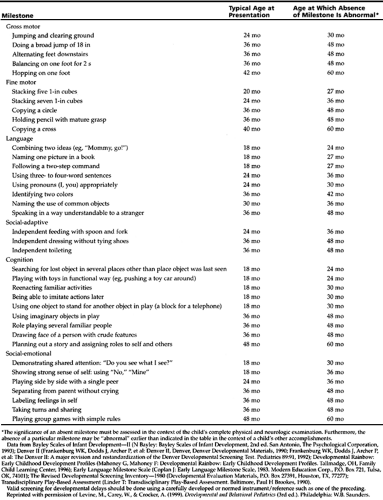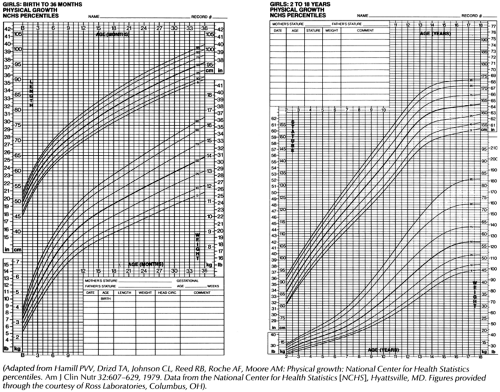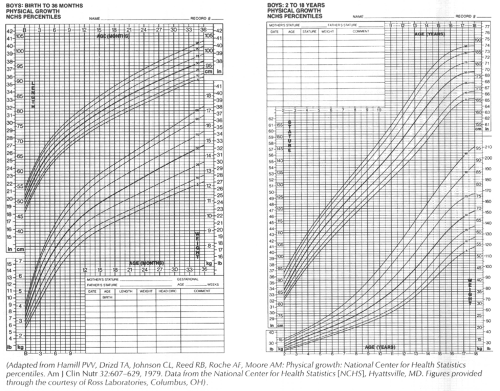Healthy Growth and Development of the Preschool Child
Noreen Mulvanerty MS, RN, CS, FNP
Dee L’Archeveque MD
INTRODUCTION
The preschool child, ages 3 to 5, experiences a magical period of curiosity and activity. During these years, children require an enormous amount of attention; consequently, the primary care provider must be patient and innovative. He or she must fully assess the child during this period for changes in physical, psychosocial, cognitive, and emotional development. Identifying normal patterns of growth and development and detecting variations are important indicators as the preschooler progresses toward readiness for school. Parents and caregivers look to the clinician for advice about their child. Their concerns range from nutritional issues to nightmares and everything in between. A trusting relationship between provider, family members, and child is essential to provide quality patient care through health promotion, disease prevention, and anticipatory guidance.
GROWTH AND DEVELOPMENT
Developmental assessment is based on the conviction that patterns observed in the early years of life are sequential and predictable. Biologic maturation reflects developmental changes influenced by the environment. Individual variations from norms may be transient and simply need further evaluation. Assessment of development can be integrated in the pediatric examination. It involves a thorough history, familiarity with normal development, knowledge of familial and environmental influences, and awareness of developmental indicators.
Early clinical intervention in children with developmental problems is necessary for successful development. Such intervention only can occur by recognizing subtle variations in growth and development from the norm. Valid assessment requires both quantitative and qualitative measurements of the developmental process. A common clinical perspective is the identification of sequential milestones normally achieved at specific ages. Development also can be seen as a series of tasks to be mastered within certain stages. Other perspectives are derived from stage-based theories, such as Freud’s theory of psychosexual stages or Piaget’s stages of cognitive growth.
Physical Development
Gains in weight and stature usually are constant during the preschool years. Children ages 3 to 5 continue to grow at a much slower pace than they did in the first year of life. The average child gains 7 cm (2 in) in height and 2 kg (approximately 1 lb) in weight per year, with boys gaining slightly more than girls. As lordosis becomes less pronounced, the abdomen flattens and the body appears leaner. Head growth declines markedly, with head circumference increasing only 2 cm (1 in) each year; subsequently, the face becomes elongated. In comparison, the legs grow faster than the trunk, head, or upper extremities (Murphy, 1996).
Generally by age 3 years, visual acuity reaches 20/40; by age 4 to 5 years, it reaches 20/30; and by age 6 to 7 years, it reaches 20/20. By age 3 years, all 20 primary teeth have erupted. Muscle development and bone growth are still in the stages of maturation. Motor development increases in strength and refinement. Most children walk with a steady gait before the end of their third year. At age 3 years, the preschool child should be able to ride a tricycle, walk on tiptoe, and balance on one foot. By 4 years, the child can skip and hop on one foot and can catch a ball. By 5 years, the child can skip on alternate feet. Fine motor skills are evident in the abilities of drawing and dressing oneself. Table 10-1 outlines the age of presentation of physical and psychosocial developmental milestones (Levine, Carey, & Crocker, 1999).
• Clinical Pearl
As the child normally grows, the parents might mistake this for weight loss. Keeping clear records and growth charts can be reassuring to both the clinician and parents.
Understanding physical development is essential to understanding normal milestones attained during the preschool years. As external signs of change become evident, the internal organ infrastructure also undergoes growth, which allows the child to develop normally.
Neurologic Development
By age 2 years, significant brain maturation occurs, with myelinization finalized between the cortex and the thalamus and basal ganglia. All layers of the cortex reach a similar state of maturation between 15 and 24 months (Rabinowicz, 1986). The cognitive, emotional, and physical abilities of the preschooler are related to brain maturation. Sensory function becomes more developed, and the awareness of a full rectum or bladder accompanies the ability to control the rectal sphincter. As neural growth slowly continues, the child performs more complex tasks.
Cardiovascular Development
Growth of the cardiac structure continues through the preschool years. By the fifth year, the size of the heart has quadrupled since birth. The heart rate declines to 70 to 100 beats per minute as the myocardium grows and energy demands decrease. Adult levels of pulmonary vascular resistance and pulmonary arterial pressure are attained before reaching age 2 years; therefore, the physical examination
should reveal regular rate, with an innocent murmur possible as the heart gains size throughout this phase. See Chapter 37 for information on distinguishing heart murmurs.
should reveal regular rate, with an innocent murmur possible as the heart gains size throughout this phase. See Chapter 37 for information on distinguishing heart murmurs.
Respiratory Tract Development
Growth and development of the respiratory system encompass changes in anatomy, mechanical properties, and metabolic and defense functions. The number of alveoli, the basic gas exchange unit, and its associated structures increase throughout childhood; conversely, the respiratory rate slows from infancy to approximately 20 to 30 breaths per minute. As the diaphragm matures, abdominal respiratory movement decreases. By the end of the fifth year, respiratory movement becomes more diaphragmatic.
Gastrointestinal Development
By age 5 years, the gastrointestinal (GI) tract is enzymatically mature, enabling the child to eat and digest a wide range of foods. Anatomically, the stomach is relatively small. Children who have anatomically intact GI tracts can enjoy many foods but need nutritional guidance to ensure normal growth. Healthy snacks should be encouraged between meals to support nutritional requirements (Murphy, 1996).
Psychosocial and Cognitive Development
As preschool children deal with the world around them, they use their developing language skills, knowledge of the environment, and play activities. Vocabulary increases during this period from 50 to 100 words to more than 2000. In turn, the use of language as an expressive tool increases. Language plays a critical role in the regulation of behavior. Children during these years understand the inhibitions that surround them and are able to express feelings, anger, and frustration without acting out.
• Clinical Pearl
Language-delayed children exhibit higher rates of tantrums and other externalizing behaviors (Behrman, Kilegman, Aruin, 1996).
The preschool period corresponds with Piaget’s preoperational stage, which is characterized by magical thinking and egocentrism. The child uses magical thinking to explain the surrounding world; for example, “the sun goes down because it is tired and needs to sleep.” Egocentrism is the inability to see another’s point of view; however, this does not connote selfishness. The preschool child is developing hypotheses about the nature of the world as multiple aspects of a situation (Levine et al., 1999).
Play activities during the preschool years are increasingly complex and imaginative. This period also is marked by increased cooperative play and play that is increasingly governed by rules.
HISTORY AND PHYSICAL EXAMINATION
Primary care is delivered in myriad settings. Common to all settings is the consideration of privacy for the patient and family. The clinical setting should be a comfortable place for patients and family to sit and interact with the provider. A soothing environment with child-friendly artwork and furniture creates a pleasant atmosphere in which children feel relaxed, fostering better communication between the provider and family.
The examination room should be comfortable and safe for children of all ages. Providers should be mindful that wearing a white lab coat might evoke a fearful response from the pediatric patient. When interviewing the patient and family, the provider should sit, establishing and maintaining eye contact with the patient and family.
• Clinical Pearl
Friendly interaction with the patient’s parents decreases the child’s anxiety. Using a jovial and calming tone alleviates anxiety in both parent and patient.
History Taking
A thorough history is essential to a comprehensive well child visit (Display 10-1). Information related to the child’s psychosocial environment is necessary for the provider to interpret information from the family during all subsequent visits and if problems arise in the child’s growth and development.
DISPLAY 10–1 • History Elements Reviewed During an Annual Preschool Child Visit
Family psychosocial status
Milestones
Language
Cognitive
Emotional
Spiritual
Elimination habits
Nutrition habits
Medication intake
Sleep habits
Television watching
Dental hygiene
Immunization status
Tuberculosis risk factors
Anticipatory guidelines are adapted from Murphy’s 1996 section on the developmental management of toddlers and preschoolers in Pediatric primary care: A handbook for nurse practitioners.
• Clinical Pearl
Interest in the family is not only essential in treating the patient but also establishes good rapport with all family members that can assist in the development of a trusting relationship between provider and patient.
To satisfy the preschool child’s need to know continually what is happening, the provider should explain each step of the examination. For example, “I’m going to talk to your caregiver(s) about how you are doing at home. If you have any questions or want to add anything, let us know.” Treating the child as an active participant instead of a passive object will foster a positive relationship between the provider and the patient. Additionally, encouragement of verbal participation in the 3- to 5-year-old enhances the idea of active partnership in all aspects of their health care. The use of drawings to illustrate and explain parts of the anatomy and medical problems can be very helpful to the patient and the family.
Vague complaints or concerns voiced by parents present an opportunity for the provider to use anticipatory guidance about many psychosocial issues and to reassure the parent that the child is developing normally. The well child visit must allow adequate time to explore psychosocial aspects of the child’s environment and to answer questions regarding
topics such as eating and sleeping patterns, discipline issues, and television viewing.
topics such as eating and sleeping patterns, discipline issues, and television viewing.
During the preschool visit, it is important to elicit consistently the history of both physical and social development. During the initial well child visit, the provider should obtain additional historical information, including mother’s prenatal history, pregnancy-related illness or medication or drug usage, birth information, neonatal history of growth and feeding, and significant familial genetic history. Understanding the child’s environment is very important, and its importance should be clearly explained to the caregiver before asking questions regarding caregiver arrangements, home environment, people in the home, financial structure, occupation of caregivers, and marital status.
The provider who is just focusing on the history and not observing the child is missing a key to the child’s physical and psychosocial development.
Each primary care practice group should have a comprehensive format to follow to ensure everything from immunizations through anticipatory guidance are addressed during the initial and all subsequent patient visits. Each intake of information also should be tailored to the individual’s needs and parental concerns. The provider should track intercurrent illnesses and major growth and developmental changes and have records available for parents to review. Educational materials and resources for reference also should be available.
Physical Examination
During the well child visit, most developmental testing should be completed (Display 10-2). The provider should use a standardized developmental tool, such as the Denver Developmental Screening Tool II. The child should be examined after the history and most developmental testing is completed. This helps to reduce the patient’s anxiety toward the provider, thereby increasing the caregiver’s comfort when the provider examines the child.
DISPLAY 10–2 • Physical Examination Elements During the Annual Preschool Child Visit
General physical appearance
Weight
Height
Skin (take images)
Head
Size/shape
Fontanelles closed
Eyes
Size/shape/equal
Visual acuity
Red reflex
Ears
Hearing
Internal canals
Nose/throat
Teeth hygiene
Nasal polyps
Neck
Lymph nodes
Respiratory
Inspection
Auscultation
Cardiology
Auscultation
Gastrointestinal
Hernias/organ size
Rectum
Genitourinary
Females: Vagina
Males: Foreskin/testicles
Check for sexual abuse
Neurologic
Motor
Sensory
Musculoskeletal
Exposure
Inspection
Anticipatory guidelines are adapted from Murphy’s 1996 section on the developmental management of toddlers and preschoolers in Pediatric primary care: A handbook for nurse practitioners.
Normal Versus Abnormal Variations
Growth can be measured within percentile ranges on standard growth charts for girls and boys, such as the classical National Center for Health Statistics (NCHS) growth charts from the 1960s and 1970s (Fig. 10-1 and Fig. 10-2). The following are four principles to assess normal growth:
Accurate data
Discontinuous growth
Single value
Time as a tool (Legler & Rose, 1998)
• Clinical Pearl
Crossing percentile lines on standardized growth charts between the ages of 3 to 12 for boys and 3 to 10 for girls is abnormal and requires further evaluation.

Full access? Get Clinical Tree







